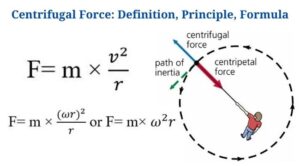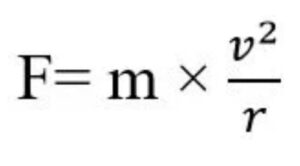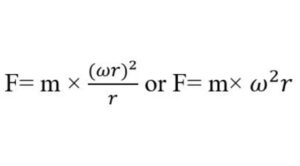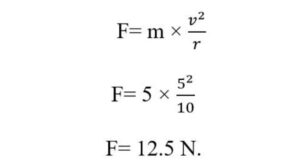Definition of Centrifugal Force
Centrifugal force is a fictional outward force experienced by an item travelling in a circular direction away from the center of rotation.
- Centrifugal force is directed away from the axis of rotation and parallel to the axis of rotation.
- The magnitude and dimensions of centrifugal force are the same as those of another force (centripetal) acting towards the centre of a circular path.
- It is referred as a fictional force since it only appears when there is a centripetal force. This force is caused by the body’s inertial property as it moves in a circular direction.
- The force, though, is affected by the mass of the object, its distance from the center, and the rotational speed.
- Centrifugal force has indeed been employed in a variety of rotating equipment such as centrifuge rotors, banked highways, and centrifugal pumps.
- Newton is the unit of centrifugal force, and the dimensional formula is M1L1T-2.
Centrifugal Force Formula
The formula for calculating centrifugal force is shown below.
If the velocity of the moving object is known, the centrifugal force may be calculated using the formula below:
where v is the moving body’s velocity, r is the moving body’s distance from the center, and m is the moving body’s mass
If the angular velocity of the moving item is known, the centrifugal force may be calculated using the formula:
where ω is the angular velocity, r is the moving body’s distance from the center, and m is the moving body’s mass.
Centrifugal Force Principle
- As previously stated, the centrifugal force is fictional or pseudo since it exists only if there is a centripetal force.
- When a passenger automobile turns the wheel, the vehicle is propelled by centripetal force, which operates on all elements of the vehicle.
- When the vehicle begins to turn, the passengers in the automobile keep their freedom of movement and so maintain a straight course.
- As a result, the passengers shift to the edge of the seat, near the door, delivering the centripetal force to them.
- The occupants experience centrifugal force as they move away from the car.
- According to Newton’s second law of motion, acceleration is caused by force, hence this is not a true force according to Newton’s law of motion.
- When a stone at the end of a rope linked to a pole on the ground is rotated, the direction of the stone’s velocity changes constantly, causing acceleration.
- If the string snaps, the stone keeps its inertia and moves in a straight line parallel to the circular path.
- When centrifugal force exists, the stone would move in an outward rather than tangential direction.
What is the formula for calculating centrifugal force?
Let us use the same example of the stone at the end of the string connected to a pole for this. The following methods can be taken to compute the centrifugal force experienced by the stone:
- Determine the stone’s mass (m). Assume the mass is 5 kg.
- Find out the string’s length. Assume the length is 10 m.
- Find out the stone’s velocity. Let’s say the tangential force is 5 m/s. Tangential velocity (v) or angular velocity () can be used to describe velocity. The tangential velocity can be computed if the velocity is the angular velocity:
v = ω × r
4. Using the following formula, calculate the centrifugal force:
As a result, the centrifugal force is 12.5 N.
Centrifugal force applications
Despite the fact that Newton’s law does not regard centrifugal force to be real, it has a variety of applications:
- Centrifuges operate on the principle of centrifugal force. The centrifugal force of the rotors causes a hydrostatic pressure gradient in the tubes perpendicular to the axis of rotation. As a consequence, larger buoyant forces push less dense particles inwards while pushing denser particles out. Particles can be separated using this technique based on their densities.
- A centrifugal governor is a system that maintains an engine’s speed by moving the fuel or working liquid radially due to centrifugal force.
- Centrifugal forces are employed to produce artificial gravity in spinning space stations. These stations aid in the simulation of gravity’s effects on other plants.
- Centrifugal force is also used in washing machine dryers, where the spinning of the rotor of a washing machine generates centrifugal force, causing the garments to migrate away from the center. As a result, the water is forced out of the wet clothes through the chamber’s apertures.
- In amusement park rides, centrifugal forces are used to press riders against the wall, enabling the passengers to be hoisted above the bottom of the machines.
Centrifugal force examples
Centrifugal force can be observed in a variety of processes in our daily lives; some examples are provided below:
- The force pushing on the occupants in a car outwards as the automobile is turning is an example of centrifugal force.
- Whenever a stone on a string is spun in a circle, the force generated on the hands is also due to centrifugal force.
- Since the centrifugal force acting on particles near the equator is greatest, the globe is flattened at the pole and bulged at the equator.
- If a bucket full of water is turned in a circle, the water does not fall because the centrifugal force acting on the bucket balances the weight of the bucket.
- As an outcome of centrifugal force, mud lodged on car wheels is propelled tangentially towards the mudguard.
Image Source: Wikia.
Difference between Centripetal and Centrifugal Forces
(Centripetal Vs Centrifugal Force)
[ninja_tables id=”5375″]
Centrifugal Forces Citations
- https://en.wikipedia.org/wiki/Centrifugal_force_(rotating_reference_frame)
- https://www.scienceabc.com/nature/what-is-centripetal-acceleration-what-is-centrifugal-force.html
- https://www.sarthaks.com/204136/stone-tied-string-length-whirled-vertical-circle-with-the-other-end-the-string-the-centre
- https://www.reference.com/science/centripetal-force-involved-operation-washing-machine-ee15394203b35628
- https://www.meritnation.com/ask-answer/question/a-stone-tied-at-the-end-of-string-is-whirled-in-a-circle-if/laws-of-motion/7284551
- https://www.ielts-mentor.com/writing-sample/writing-task-2/1313-ielts-writing-task-2-sample-323-the-private-motor-vehicle-has-greatly-improved-individual-freedom-of-movement
- https://www.britannica.com/science/centrifugal-force
- https://www.answers.com/Q/What_does_the_mass_of_an_object_depend_on
- https://wikimili.com/en/Centrifugal_force
- https://thenewtonslaw.com/what-is-newtons-second-law-of-motion/
- https://in.answers.yahoo.com/question/index?qid=20080210081429AA8WTcC
- https://byjus.com/physics/centripetal-and-centrifugal-force/
- https://brainly.in/question/8429538
- http://bioedonline.org/lessons-and-more/lessons-by-topic/plants-form-function/how-does-gravity-affect-root-growth/
Related Posts
- Phylum Porifera: Classification, Characteristics, Examples
- Dissecting Microscope (Stereo Microscope) Definition, Principle, Uses, Parts
- Epithelial Tissue Vs Connective Tissue: Definition, 16+ Differences, Examples
- 29+ Differences Between Arteries and Veins
- 31+ Differences Between DNA and RNA (DNA vs RNA)
- Eukaryotic Cells: Definition, Parts, Structure, Examples
- Centrifugal Force: Definition, Principle, Formula, Examples
- Asexual Vs Sexual Reproduction: Overview, 18+ Differences, Examples
- Glandular Epithelium: Location, Structure, Functions, Examples
- 25+ Differences between Invertebrates and Vertebrates
- Lineweaver–Burk Plot
- Cilia and Flagella: Definition, Structure, Functions and Diagram
- P-value: Definition, Formula, Table and Calculation
- Nucleosome Model of Chromosome
- Northern Blot: Overview, Principle, Procedure and Results




















